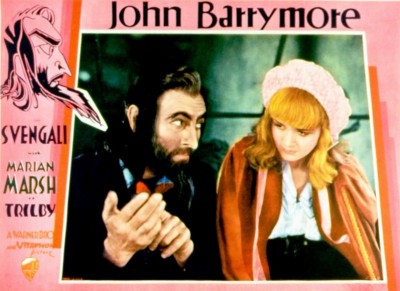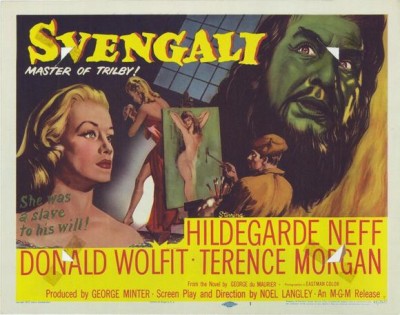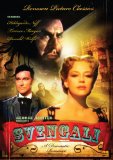| Reviews & Columns |
|
Reviews DVD TV on DVD Blu-ray 4K UHD International DVDs In Theaters Reviews by Studio Video Games Features Collector Series DVDs Easter Egg Database Interviews DVD Talk Radio Feature Articles Columns Anime Talk DVD Savant Horror DVDs The M.O.D. Squad Art House HD Talk Silent DVD
|
DVD Talk Forum |
|
|
| Resources |
|
DVD Price Search Customer Service #'s RCE Info Links |
|
Columns
|
|
|
Svengali (1931 & 1954 versions)
Svengali is based on George du Maurier's 1894 gothic horror novel Trilby, though film versions seem equally influenced by real-life Russian mystic/charlatan Rasputin's influence over the Tsaritsa Alexandra, which began a decade or so later, and the 1931 Svengali may also have been influenced by the Broadway and film versions of Dracula. (Most of it was filmed before the movie Dracula's premiere, however, so the similarities may be only coincidental.)
Set in turn of the century Paris, the '31 Svengali is a showcase for the flamboyant John Barrymore. A pompous minstrel-music teacher as famous for his body odor as his musical ability, Svengali "would either fawn or bully, and could be grossly impertinent," according to the novel. "He had a kind of cynical humor, which was more offensive than amusing, and always laughed at the wrong thing, at the wrong time, in the wrong place. And his laughter was always derisive and full of malice." In early scenes in the film, Barrymore's character is a bit more gentlemanly, gregarious, and comical.
This gradually changes as Svengali vies for the affections of Trilby O'Farrell (Marian Marsh) an unassuming artists' model, with a young painter, Billee (Bramwell Fletcher, best-remembered today for his small part as the terrified witness of The Mummy's resurrection). But Billee is no match for Svengali's growing hypnotic control over Trilby. Eventually she disappears and is presumed to have drowned herself in the Seine, but in fact Svengali has mesmerized Trilby into a near-permanent zombie-like state. He passes her off as his wife and through his extraordinary powers fashions the tone-deaf Trilby into an internationally-acclaimed concert singer.
The 1931 Svengali is notable for its incredible expressionistic set design by Pole Anton Grot - which looks more Eastern European than anything in Paris - and similarly highly stylized costumes and makeup, along with some startling special effects that continue to amaze nearly 80 years after it was made. One shot in the film is downright flabbergasting; I'd like to know how it was done. The camera is in close-up on Barrymore's face, with Svengali in hypnotic mode - his glassy pupil-less eyes (apparently early contact lenses atmospherically enhanced with pinpoint lighting) staring blankly into the camera. Then the camera tracks backward away from Svengali, through his second-storey window and over the rooftops of Paris (an elaborate model) all the way to Trilby's apartment. There's no obvious cut between the live-action Barrymore and the elaborate miniature, and no clear explanation how the camera was able to move backward through the apparently miniature window, while simultaneously having the camera locked on Barrymore.
The actor rolls his eyes and gestures extravagantly as the larger-than-life Svengali with the kind of hamminess that was increasingly dominating his sound era performances, but in this case it's a legitimate approach to the character. However, horror fans who think Bela Lugosi was over the top in Dracula should look at this; compared to Barrymore, Lugosi is almost restrained. Marsh, who passed away only recently, has a doll-like charm as Trilby; though her film career seems confined to the sound era, her performance here is like something out of the silent era (in the good sense). Donald Crisp and Lumsden Hare, hidden behind stylized beards and muttonchops, are a delight as two of the novel's supporting characters, painters "The Laird" and Taffy.
And though generally not thought as such - few genre fans would group this with other "first-cycle" horror films like Dracula, Frankenstein, and Island of Lost Souls - in fact Svengali is very much a horror film with fantastic, classical elements. (Movie rating: *** 1/2)
The 1954 British film fleshes out the characters of Trilby and Billee considerably and adds a lot of color and subtlety, but the results suggest that a more flamboyant approach might have worked better than the lush but tame version that resulted. The Eastman Colour production aims for an evocative atmosphere akin to John Huston's gorgeous Moulin Rouge (1952), photographed in Technicolor by Oswald Morris. Svengali was made on a fraction of that film's budget, though does look handsome for what it is.
Hampering the film's success is its cast. Second-billed Donald Wolfit (Blood of the Vampire, Lawrence of Arabia, etc., though best-known today as the inspiration for Albert Finney's character in The Dresser) was a mid-production replacement for Robert Newton (Treasure Island), who like Barrymore 20 years before was a notorious drunk and had developed a reputation as unreliable. (This reviewer's all-time hilarious Hollywood anecdote features Newton. Do yourself a favor: take 15 minutes and check it out here.) Newton can still be seen in the film in some long shots.
Though Wolfit could be as hammy as Newton, he curiously underplays Svengali, at least he's much less the wild-eyed maniac Barrymore is. Add to that, the film strongly plays down the story's supernatural qualities, possibly due to the fact that the gothic horror genre was at its nadir in the mid-1950s before Britain's Hammer Films revitalized it.
Hildegard Knef (The Lost Continent), though she gives a sensitive performance, is likewise miscast; her pronounced German accent and features are simply not acceptable as an Irishwoman in Paris. However, as adapted by Noel Langley (The Wizard of Oz, The Prisoner of Zenda), Trilby is more complex, a woman both strong and streetwise yet also fragile and impressionable, while her romance with Billee is expanded to allow for some criticism of the British class system. (** 1/2)
Video & Audio
The transfer for the 1931 Svengali seems to have originated from somewhere other than VCI. The image is extraordinarily clean and the titles are window-boxed. The audio has a computer-processed artificiality here and there but otherwise is fine.
Despite claims that the 1954 version was "digitally restored from the 35mm negative," the image is muddy and extremely soft. On the plus side it's clean; there's little in the way of dirt, scratches and the like but it's so lacking in definition as to suggest an old tape master, not something newly transferred for DVD in 2009. The full frame presentation is also questionable. By late 1954 when this was released, most British films were being framed for 1.66:1 projection, while the MGM logo included on this U.S. print (where it was released in late-1955) also suggests a 1.66:1 or maybe 1.75:1 theatrical aspect ratio. Reformatted to 16:9 television, the image is a bit too tight in a few shots; I suspect 1.66:1 was probably the original intent. The Dolby Digital mono audio is okay; optional English subtitles accompany the remake but not the '31 film.
Extra Features
Besides the 1931 Svengali, other supplements include a fairly detailed photo gallery with images from both versions, and Richard Gordon Remembers George Minter, an excellent interview conducted by Tom Weaver which is obviously culled from material prepared for the DVD of the 1951 A Christmas Carol/Scrooge, from which numerous clips are shown.
Parting Thoughts
Of the various DVD version of the 1931 Svengali out there, this is probably the one to get because it's pretty cheap and you get the remake as a bonus - the opposite of how this is being sold. Mildly Recommended.
Film historian Stuart Galbraith IV's latest book, Japanese Cinema, is due in stores this June, and on sale now.
|
| Popular Reviews |
| Sponsored Links |
|
|
| Sponsored Links |
|
|
| Release List | Reviews | Shop | Newsletter | Forum | DVD Giveaways | Blu-Ray | Advertise |
|
Copyright 2024 DVDTalk.com All Rights Reserved. Legal Info, Privacy Policy, Terms of Use,
Manage Preferences,
Your Privacy Choices | |||||||














